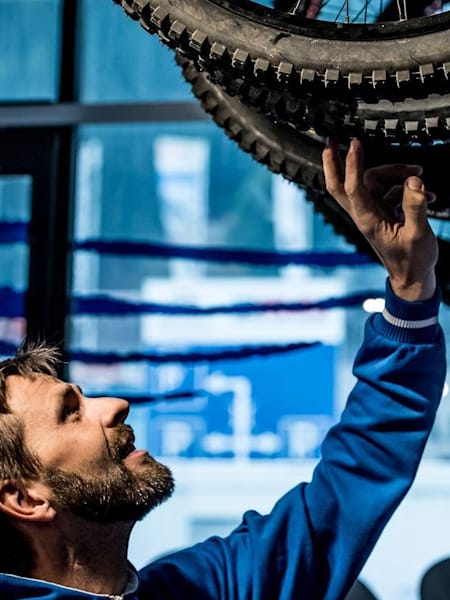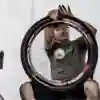What could possibly distinguish one wheel from another? Surely they’re all just round things with a tyre on the outside? Funnily enough, mountain bike wheels are a bit more complicated than a round thing (rim) with stick-like things (spokes) and a central hub-like thing (hub).
A basic understanding of what makes a good wheel can really help in setting up a good bike.
Here’s a brief back-to-basics glossary of wheel terminology, then some more complicated details explained with the help of Arnaud Petit-Laurent of the esteemed wheel manufacturer, Mavic.
Terminology
Rim: The outermost component in a wheel. The bit the tyre sits on.
Hub: The centrepiece of the wheel, from which the spokes branch out to the rim. Rotates around the axle, which is an external component attached to the fork or frame.
Spoke: The rods connecting hub to rim. J-Bend spokes are most common – they are identified by the bend at the hub end, and thread into the nipple at the rim. Straight-pull spokes have no bend and, as they are often proprietary to the wheel they are made for, are less readily available in bike shops.
Hub flange: The collar of the hub that the spokes attach to.
Nipple: Small component spokes screw into at the rim.
Eyelet: A fitting in the rim that holds the nipple in place.
Lacing: The pattern in which the spokes are threaded when building a wheel. The exact same wheel threaded in a different pattern can produce a completely different ride character.
True: A straight wheel is called ‘true’. If it gets a wobble, usually caused by the spokes unequally going out of tension, it is out of true.
Some Wheel Mysteries Explained
How many spokes are there?
There is no standard number of spokes. Different wheels for different purposes and with differing materials and thicknesses vary in spoke count. However, 24, 28 and 32 are common numbers.
Can I ride with a missing spoke?
It’s not recommended. However, in most cases you can probably limp the wheel home then get the spoke replaced and wheel trued as soon as possible to avoid any long-term damage.
What sort of different spokes are there?
Aside from the way they fix to the hub and rim (J-Bend or straight-pull), there are other key differences in spokes. Most are made from steel or aluminium, and quality really does affect the wheel’s character.
- Butted spokes vary in profile along their length, according to where most/least material is needed. This allows strength-weight to be maximised. Single-, double- and triple-butted spokes offer varying benefits and price tags
- Straight gauge spokes do not vary in profile along their length
- Bladed, or ‘aero’ spokes have a flat profile, which can help with aerodynamics
What difference do various spoke lacing patterns make?
The way in which a wheel’s spokes are laced can affect its stiffness, weight and strength, changing the ride character of a wheel. There are many lacing patterns and no ‘standard’, but two- and three-cross are common.
To take two- and three-cross lacing patterns as an example, this refers to the number of times each spoke crosses another spoke on its way from hub flange to rim. This alters the angle of the spoke reaching from hub to rim, and therefore the way it will deal with torsional, radial and lateral forces.
But it’s not a simple science! A balance must be struck between weight, strength and rigidity, which is why certain wheel manufacturers or builders might lace differently according to rim profile, spoke count and type, rider and purpose.
A radial build means the spokes connect straight from hub flange to rim without crossing any other spokes. There are also many other patterns that some wheel builders like to dabble with.
Can spoke tension be ‘tuned’?
There is one school of thought that says greater spoke tension equals stiffer wheels, and loosening the spokes gives more flex and deflection (for traction and comfort). In reality, there are more effective ways of changing the behaviour of a wheel. There is a minimum safe tension, and if you go below it straight-pull spokes can be ejected, or a whole wheel could potentially collapse. Going above a normal/safe tension might make the wheel slightly stiffer, although this is almost unnoticeable due to greater flex elsewhere in the tyre, frame and components, plus you are more likely to break a spoke under heavy impact. The more efficient alternative if you’re looking for a more compliant or more rigid wheel would be to change the spoke type or lacing pattern.
Can I ride with a dented rim?
Dents from rock hits are quite common, and smaller dents aren’t a big problem if the rim isn’t cracked. However, bigger dents will likely cause the tyre to deflate or eject… you’ll soon know if this is the case!
What is Boost?
Boost is a trademarked name for a 148mm rear and 110mm front hub width. Introduced in 2015, Boost increased hub width from 142mm and 100mm rear/front respectively, the width that had become fairly standard in mountain biking at that point. With wheel size increasing (more people producing 29-inch wheeled bikes), the wider hub was introduced to allow greater wheel stiffness (due to increased spoke brace angle thanks to wider hub flange), as well as improved tyre clearance and a host of other frame-related benefits. It is still not the standard but is prolific across new bike ranges. It won’t make you go faster – that comes with skill and experience.
Why wide rims?
The average mountain bike rim has been getting wider and wider in recent times. This is for several reasons, namely:
- As tubeless tyres become prolific, a wider rim creates greater base stability for the tyre, meaning when it is loaded with side-on pressure (in a banked turn, for example), it is less likely to squirm or come off the rim (a traditional inner tube creates added support, but it is more prone to punctures and heavier)
- Greater stability allows lower tyre pressures, meaning increased grip
- Mountain bike tyres have got wider in general, so rim width has adapted to suit
As a note, wider rims lead to an altered tyre profile (it becomes squarer), and some companies have addressed this with specific tyres. Maxxis’ WT (Wide Trail) tyres for example.
Do I need carbon rims?
Carbon rims are now fairly common in mountain biking. In its carbon layering process, the profile of the rim can be tweaked to suit a precise rigidity and reduce weight in places. But conversely, carbon can be more susceptible to failure, meaning that more material must be added in other areas. Therefore, weight differences between carbon and alloy rims are minimal. A good carbon rim compared to a poor quality one is not only more durable, but its ride characteristic can be wholly different. Cheap knock-offs look the part, but the layering and fibre direction might not have been considered.
Aluminium-alloy rims are still popular and used across many wheel manufacturers’ ranges. A quality rim at an affordable price is more realistic than its carbon alternative and is less likely to fail under an impact (i.e. from a rock colliding with the rim). As noted, it isn’t necessarily a heavier option either: Mavic, for example, use a process called ISM 4D to remove any and all unnecessary material from their alloy rims (giving the distinctive bulge around the spoke nipples), resulting in a lightweight, yet dependable rim.
The wheel as a complete system
Mavic’s Arnaud Petit-Laurent notes:
“The wheel is a very complex system where all the components have their importance. Mavic chooses to develop a complete system with specific technologies to control every parameter and the behaviour of the wheel, finding the best compromise between tolerance and performance.
In terms of rigidity, for example, we can modify many parameters with regards to the rims, spokes and hubs, and modify at the same time the overall behaviour of the wheel. We need to focus on what the consumer or rider wants for their bike and play with all the components to reach the best possible wheels.”









